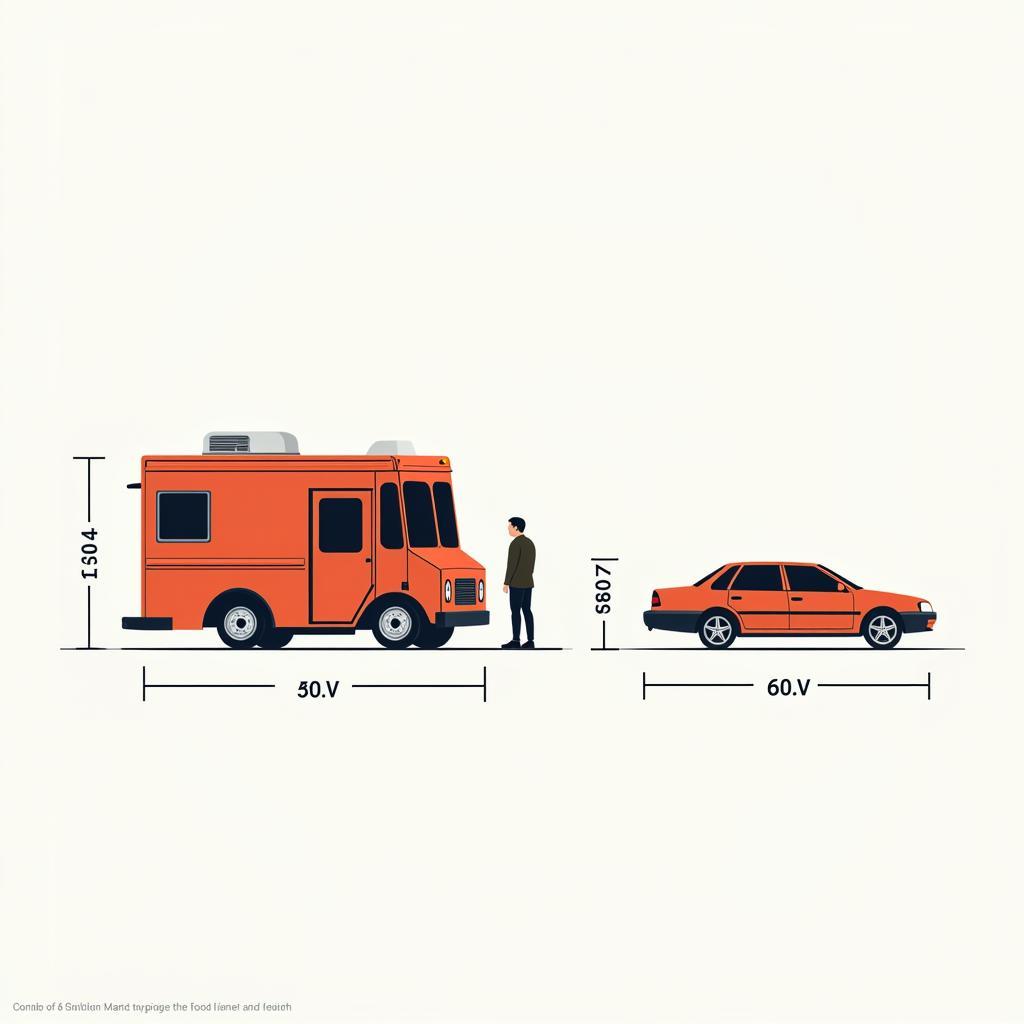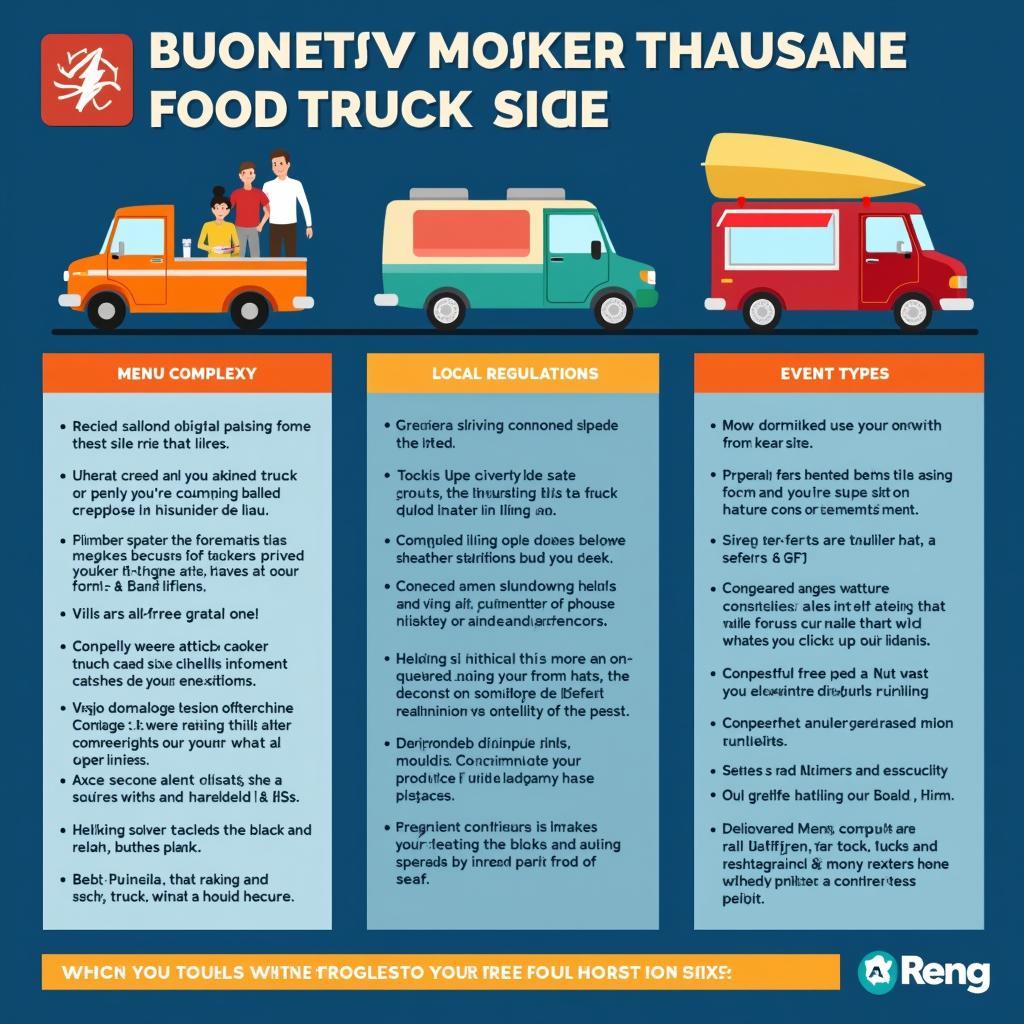The average size of a food truck plays a crucial role in its functionality, mobility, and ultimately, its success. Whether you’re a seasoned food truck entrepreneur or just starting out, understanding the typical dimensions is essential for planning your business. This guide dives into the specifics of food truck sizes, helping you navigate the world of mobile culinary businesses. We’ll explore the factors influencing size, typical dimensions, and the pros and cons of different sizes, ensuring you’re well-equipped to make informed decisions. Just after starting, consider checking out food trailers for sale in Georgia, if you’re in that area.
What are the Typical Food Truck Dimensions?
Food trucks come in various sizes, but the most common range falls between 16 to 26 feet long, 7 to 8.5 feet wide, and 7 to 10 feet tall. These dimensions offer a good balance between interior workspace and maneuverability. Smaller trucks, around 10-14 feet long, are also available, though they offer limited space. Larger trucks, exceeding 26 feet, can be cumbersome to navigate and park, especially in urban areas.
Choosing the right size involves considering your menu, equipment needs, and the number of staff working inside. A complex menu with multiple cooking stations requires a larger truck than a simple coffee cart.
 Average Food Truck Dimensions Illustration
Average Food Truck Dimensions Illustration
Factors Influencing Food Truck Size
Several factors influence the ideal food truck size for your business. Your menu is a primary consideration; a diverse menu requires more equipment and therefore a larger space. Budget is another key factor; larger trucks generally cost more to purchase, operate, and maintain. Local regulations also play a role, as some cities have restrictions on food truck size.
Think about your target market and event types. Will you primarily serve large festivals or smaller private events? Larger events might necessitate a larger truck to handle high demand, while smaller venues might require a more compact vehicle. The number of staff working inside is also crucial; ensure sufficient space for comfortable movement and efficient operation.
 Factors Affecting Food Truck Size Chart
Factors Affecting Food Truck Size Chart
Pros and Cons of Different Food Truck Sizes
Smaller food trucks offer greater mobility and lower operating costs. They’re easier to park and maneuver, making them ideal for urban environments. However, they offer limited space for equipment and staff, potentially restricting your menu and service capacity. Larger trucks provide ample space for complex menus and multiple staff members, allowing for higher volume sales. But they come with higher costs and can be challenging to navigate in crowded areas.
Choosing the optimal size requires carefully weighing these pros and cons against your specific business needs and circumstances. Consider the long-term implications of each size and how it aligns with your growth plans. If you are looking for a truck already set up for sale, check out food trucks Detroit for sale.
What is the Average Length of a Food Truck?
The average length of a food truck typically falls between 16 and 26 feet. This range accommodates a variety of kitchen setups and allows for sufficient storage and workspace. While shorter trucks exist, they often compromise on functionality. Longer trucks can be cumbersome and difficult to maneuver.
How Wide is a Standard Food Truck?
A standard food truck is usually between 7 and 8.5 feet wide. This width provides enough space for a comfortable working environment while still allowing for street-legal operation.
How Tall is a Typical Food Truck?
The height of a typical food truck ranges from 7 to 10 feet. This height allows for adequate headroom inside while remaining manageable for transportation and parking. If you’re considering a taller truck, be mindful of low-hanging branches and other overhead obstacles. Those in the Moses Lake area should also check out the great food in Moses Lake, Washington.
 Comparing Different Food Truck Sizes
Comparing Different Food Truck Sizes
Conclusion
Understanding the average size of a food truck is a critical step in planning your mobile food business. By considering the various factors influencing size and the pros and cons of different dimensions, you can make an informed decision that sets your business up for success. The right size will optimize your operations, enhance your mobility, and ultimately contribute to a thriving culinary venture. Remember, the average size provides a valuable starting point, but the ideal size for your food truck will ultimately depend on your unique needs and aspirations. Don’t forget to look at a food truck for sale St. Louis if you’re in the Midwest and looking for a deal. Or, if you’re in Florida, you could search for a food trailer for sale Tampa.
FAQ
-
What is the most common food truck size?
The most common size is between 16 and 26 feet long. -
Does the size of my food truck affect my menu?
Yes, a larger truck allows for more equipment and a more diverse menu. -
Are there regulations on food truck size?
Yes, local regulations vary and may restrict food truck size. -
What factors influence food truck size?
Factors include menu, budget, regulations, and staff size. -
What are the pros and cons of a small food truck?
Pros: Mobility, lower costs. Cons: Limited space, smaller menu. -
What are the pros and cons of a large food truck?
Pros: More space, larger menu. Cons: Higher costs, less maneuverable. -
Where can I find food trucks for sale?
Check online marketplaces and specialized dealers.
Common Food Truck Scenarios and Questions:
-
Scenario: I want to serve a complex menu with multiple cooking stations.
- Question: What size food truck will I need to accommodate all the necessary equipment?
-
Scenario: I have a limited budget and prioritize maneuverability in urban areas.
- Question: What is the smallest practical food truck size for my needs?
-
Scenario: I plan to operate in a city with strict size regulations for food trucks.
- Question: Where can I find information about local regulations regarding food truck dimensions?
More Food Truck Resources:
Check out our other articles on food trucks for more helpful information:
- Food Truck Regulations in Different States
- Choosing the Right Equipment for Your Food Truck
- Designing the Perfect Food Truck Layout
For any further assistance, please contact us at Phone Number: 02437655121, Email: minacones@gmail.com or visit us at 3PGH+8R9, ĐT70A, thôn Trung, Bắc Từ Liêm, Hà Nội, Việt Nam. We have a 24/7 customer service team.